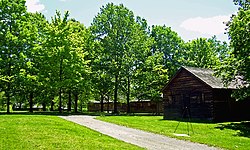
New Windsor is a town in Orange County, New York. It is in the eastern part of the county, bordering the town and the city of Newburgh. The population was estimated at 25,244 in 2010 by the US Census. The National Purple Heart Hall of Honor is located on Route 300 in the Town of New Windsor.
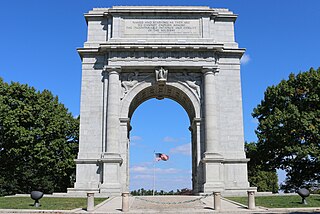
Valley Forge National Historical Park is the site of the third winter encampment of the Continental Army during the American Revolutionary War, taking place from December 19, 1777 to June 19, 1778. The National Park Service preserves the site and interprets the history of the Valley Forge encampment. Originally Valley Forge State Park, it became a national historical park in 1976. The park contains historical buildings, recreated encampment structures, memorials, museums, and recreation facilities.

Morristown National Historical Park is a United States National Historical Park, headquartered in Morristown, New Jersey, consisting of four sites important during the American Revolutionary War: Jockey Hollow, the Ford Mansion, Fort Nonsense and the New Jersey Brigade Encampment site.

Palisades Interstate Park and its governing body, the Palisades Interstate Park Commission, was formed under an interstate compact in 1900 by governors Theodore Roosevelt of New York and Foster M. Voorhees of New Jersey in response to the destruction of the Palisades by quarry operators in the late 19th century. The Palisades are the cliffs on the west bank of the Hudson River across from and continuing north of Manhattan Island. The commission consists of ten commissioners, five appointed by each governor, who serve staggered five-year terms.

Washington's Headquarters State Historic Site, also called Hasbrouck House, is located in Newburgh, New York overlooking the Hudson River. George Washington lived there while he was in command of the Continental Army during the final year of the American Revolutionary War; it had the longest tenure as his headquarters of any place he had used.
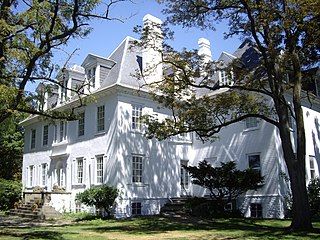
The Clermont State Historic Site, also known as the Clermont estate, the Clermont Manor or just Clermont, is a New York State Historic Site in southwestern Columbia County, New York, United States. It protects the former estate of the Livingston family, seven generations of whom lived on the site over more than two centuries.

Ringwood Manor, located in Passaic County, New Jersey, was the site of an ironworks and home to a number of well-known ironmasters from the 1740s to the late 19th century. The current manor house was not built until 1807.
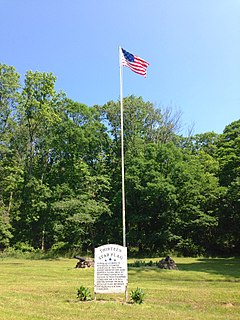
The Middlebrook encampment was a seasonal encampment of the Continental Army, commanded by General George Washington, during the American War for Independence near Middle Brook in Bridgewater Township, New Jersey in 1777 and again in 1778–79. The site includes part of the ridge of the First Watchung Mountain. Its position provided a natural fortress not only protecting the Continental Army but also overlooking the plains towards New Brunswick, where the British forces were stationed in 1777. The strategic strength of the position contributed ultimately to the success of the Continental Army by lengthening the war and wearying the British forces.

The Wallace House is a Georgian style historic house, which served as the headquarters of General George Washington during the second Middlebrook encampment (1778–79), located at 38 Washington Place, Somerville, Somerset County, New Jersey, United States. It was added to the National Register of Historic Places on December 2, 1970.

Jockey Hollow, also known as Wick House and Wick Hall, was the traditional Wick family estate in New Jersey. Throughout the Revolutionary War, it was used by the Continental Army as its main winter encampment, and it housed the entire Continental Army during the Winter at Jockey Hollow, the harshest winter of the War, from December 1779 to June 1780.

Fort Washington Park is a public park located in the Washington Heights section of Upper Manhattan in New York City. It runs along the banks of the Hudson River next to Riverside Drive and the Henry Hudson Parkway from West 155th Street to Dyckman Street. The George Washington Bridge crosses above the park, and below the bridge is the small point of land also called Jeffrey's Hook, which is the site of the Little Red Lighthouse.

Knox's Headquarters State Historic Site, in the town of New Windsor in Orange County, New York, consists of the Georgian house of the Ellison family, built in 1755 by immigrant William Bull of Hamptonburgh, NY, and the grounds around it. The site is located on Old Forge Hill Road, just south of Route 94 east of Vails Gate.

The Van Wyck Homestead Museum or Van Wyck-Wharton House is an early 18th-century Dutch colonial house in the Town of Fishkill, New York, United States of America. It served as a headquarters to a major military supply depot during the American Revolutionary War and has been listed on the National Register of Historic Places since April 13, 1972; the adjoining Fishkill Supply Depot Site has been listed on the NRHP since January 21, 1974. It is located on US 9 just south of Interstate 84. Excavations during the construction of a nearby gas station and the Dutchess Mall in the early 1970s unearthed many artifacts at the site, particularly materiel.

The Clinton House is an 18th-century Georgian stone building in the city of Poughkeepsie, Dutchess County, New York, United States. It is a New York State Historic Site and has been listed in the National Register of Historic Places as a historic place of local significance since 1982. The house was named for George Clinton, who served as the first Governor of New York and fourth Vice-President of the United States. He was believed to have lived there after the American Revolutionary War, but it is now known that it was never his residence.

The Edmonston House is located on NY 94 in the Vails Gate section of the Town of New Windsor in Orange County, New York. It has been listed on the National Register of Historic Places since 1979.

National Purple Heart Hall of Honor is located along NY 300 in the Town of New Windsor, New York, United States, less than two miles south of the Town of Newburgh line and not far from the City of Newburgh. It is a Purple Heart national registry of military personnel that have been injured or killed during combat. In 1782, at his headquarters, George Washington created the Badge of Military Merit to be given to enlisted men and non-commissioned officers for meritorious action. The museum is located at the New Windsor Cantonment State Historic Site, the last encampment of the Continental Army.
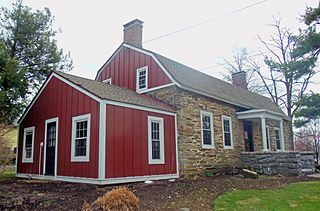
The Bergh–Stoutenburgh House is located on U.S. Route 9 opposite Mansion Drive in Hyde Park, New York. It is currently used as a district office by state senator Sue Serino.

The Jacobus Vanderveer House, also known as Knox House, is a U.S. Federal style house located just north of the community of Pluckemin in Bedminster Township, Somerset County, New Jersey at the junction of US 202 and 206 north of River Road. The house was added to the National Register of Historic Places on September 29, 1995, and noted as an "excellent example of a Dutch–American house". The Vanderveer /Knox House & Museum while owned by Bedminster Township, is operated under the direction of the Friends of the Jacobus Vanderveer House, a 501-C3 non-profit organization. The Jacobus Vanderveer House is situated on part of the 218 acres (0.88 km2) that make up River Road Park. The house was thought to be built somewhere in the mid-1770s by James (Jacobus) Vanderveer, son to Jacobus Vanderveer after the property was willed to him by his father.

There are 69 properties listed on the National Register of Historic Places in Albany, New York, United States. Six are additionally designated as National Historic Landmarks (NHLs), the most of any city in the state after New York City. Another 14 are historic districts, for which 20 of the listings are also contributing properties. Two properties, both buildings, that had been listed in the past but have since been demolished have been delisted; one building that is also no longer extant remains listed.
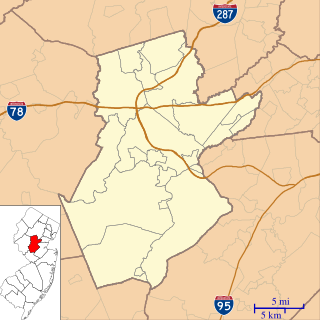
The Pluckemin Continental Artillery Cantonment Site in Pluckemin, New Jersey, at the southern section of Bedminster Township, New Jersey, holds historic American Revolutionary War importance as the Continental Army's artillery winter cantonment during the winter of 1778–79. It was nestled on the western side of the Second Watchung Mountain just to the North of the village of Pluckemin. The major significance of the site lies with the very different picture it yields of military organization during the Revolutionary War, although some point to it as the birthplace of the American military academy, 24 years prior to the founding of the United States Military Academy at West Point.
